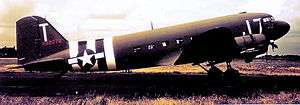50th Troop Carrier Wing
| 50th Air Division | |
|---|---|
|
| |
| Active | 1941–1946 |
| Country |
|
| Branch |
|
| Insignia | |
| 50th Troop Carrier Wing emblem (Approved 22 September 1942)[2] |
 |
The 50th Air Division is an inactive United States Air Force unit. Its last assignment was with Third Air Force at Pope Field, North Carolina. It was inactivated on 31 July 1946.
History
The wing was first established as the 50th Transport Wing, then activated on 14 January 1941. In July 1942 it became the 50th Troop Carrier Wing and was a major training organization for I Troop Carrier Command until 1943, training subordinate units in the United States prior to overseas deployment.[2]
In October 1943, became a command organization for IX Troop Carrier Command, Ninth Air Force in England. "Subordinate units began training for the invasion of continental Europe. This training involved airdropping paratroops and towing gliders."[2]
"In June 1944, subordinate units dropped paratroops of the 101st Airborne Division in Normandy, subsequently flying numerous missions to bring in reinforcements and needed supplies. During the airborne attack on The Netherlands (Operation Market Garden, September 1944), the 50th dropped paratroops, towed gliders, and flew resupply missions. Several of its subordinate units also participated in the invasion of southern France in August 1944. The 50th supported the 101st Airborne Division in the Battle of the Bulge by towing gliders full of supplies near Bastogne on 27 December 1944. In addition, its units participated in the air assault across the Rhine River in early 1945 and later flew numerous freight missions to carry gasoline, food, medicine, and other supplies to allied ground forces pushing across Germany."[2]
The wing returned to the United States in September 1945. In 1946 it became a subordinate organization of new Tactical Air Command[2] with responsibility for the theater transport (Troop Carrier) mission. It was inactivated on 31 July 1946.[2]
On 1 September 1959, the USAF redesignated the wing as the 50th Air Division; however, the division was never activated.
Lineage
- Established as the 50th Transport Wing on 8 January 1941
- Activated on 14 January 1941
- Redesignated 50th Troop Carrier Wing on 4 July 1942
- Inactivated on 31 July 1946
- Redesignated 50th Air Division on 1 September 1959 (Remained inactive)[2]
Assignments
- Office, Chief of the Air Corps, 14 January 1941
- Air Corps Maintenance Command (later Air Service Command), 15 March 1941
- Air Transport Command,[3] later I Troop Carrier Command), 30 April 1942
- Army Service Forces, c. 9 – 15 October 1943
- Ninth Air Force, c. 15 October 1943
- IX Troop Carrier Command, 16 October 1943
- I Troop Carrier Command, 29 September 1945
- IX Troop Carrier Command, 4 November 1945[4]
- Tactical Air Command, 21 March 1946
- Third Air Force, 28 March – 31 July 1946[2]
Components
Groups
|
|
Squadrons
|
|
Stations
|
|
Aircraft
|
|
See also
References
Notes
- ↑ Aircraft is C-47A-15-DK Skytrain Serial 42-92879.
- 1 2 3 4 5 6 7 8 9 10 11 12 "Factsheet 50 Air Division". Air Force Historical Research Agency. 5 October 2007. Archived from the original on 24 October 2012. Retrieved 2 April 2014.
- ↑ Not to be confused with Air Transport Command (originally Air Corps Ferrying Command).
- ↑ On 4 November 1945, I Troop Carrier Command was inactivated at Stout Field, Indiana and its personnel and equipment were transferred to IX Troop Carrier Command, which had transferred to Stout from England without personnel or equipment in September. Maurer, Combat Units, pp. 438, 448-449.
- 1 2 Station numbers in Anderson
- 1 2 Station numbers in Johnson
Bibliography
![]() This article incorporates public domain material from the Air Force Historical Research Agency website http://www.afhra.af.mil/.
This article incorporates public domain material from the Air Force Historical Research Agency website http://www.afhra.af.mil/.
- Anderson, Capt. Barry (1985). Army Air Forces Stations: A Guide to the Stations Where U.S. Army Air Forces Personnel Served in the United Kingdom During World War II (PDF). Maxwell AFB, AL: Research Division, USAF Historical Research Center. Retrieved 7 July 2012.
- Johnson, 1st Lt. David C. (1988). U.S. Army Air Forces Continental Airfields (ETO) D-Day to V-E Day (PDF). Maxwell AFB, AL: Research Division, USAF Historical Research Center.
- Maurer, Maurer, ed. (1983) [1961]. Air Force Combat Units of World War II (PDF) (reprint ed.). Washington, DC: Office of Air Force History. ISBN 0-912799-02-1. LCCN 61060979.
External links
- "Invaders: The Story of the 50th Troop Carrier Wing". Desfosses-Neogravure, Paris. 1945. Retrieved 27 January 2015. (URL is for text of booklet only)

.svg.png)
.jpg)